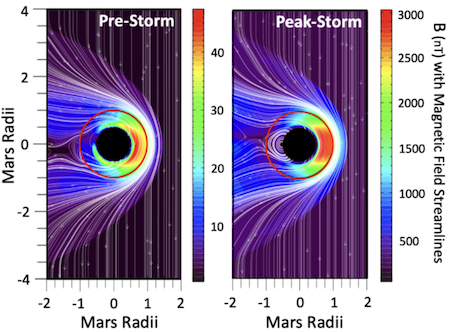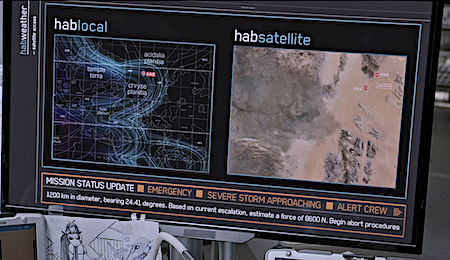Science Fiction
Dictionary
A B C D E F G H I J K L M N O P Q R S T U V W X Y Z
Mars Space Weather Alert (MSWA) System

A Mars Space Weather Alert (MSWA) system would take a comprehensive approach to providing information to astronauts on the surface of Mars, as well as those going to and from the planet.
A recent paper by James L. Green, Chuanfei Dong, Michael Hesse, C. Alex Young, Vladimir Airapetian details how an MSWA system might be approached. (SF writers have already contributed the phrase space-weather men, which might be applied to these researchers.)

(The modeled Martian responses to an extreme Carrington-type
SW event before (A) and at the peak of the solar storm (B))
Space weather observations and modeling at Mars have begun but they must be significantly increased to support the future of Human Exploration on the Red Planet. A comprehensive space weather understanding of a planet without a global magnetosphere and a thin atmosphere is very different from our situation at Earth so there is substantial fundamental research remaining. It is expected that the development of suitable models will lead to a comprehensive operational Mars space weather alert (MSWA) system that would provide rapid dissemination of information to Earth controllers, astronauts in transit, and those in the exploration zone (EZ) on the surface by producing alerts that are delivered rapidly and are actionable.To illustrate the importance of such a system, we use a magnetohydrodynamic code to model an extreme Carrington-type coronal mass ejection (CME) event at Mars. The results show a significant induced surface field of nearly 3000 nT on the dayside that could radically affect unprotected electrical systems that would dramatically impact human survival on Mars. Other associated problems include coronal mass ejection (CME) shock-driven acceleration of solar energetic particles producing large doses of ionizing radiation at the Martian surface.
In summary, along with working more closely with international partners, the next Heliophysics Decadal Survey must include a new initiative to meet expected demands for space weather forecasting in support of humans living and working on the surface of Mars. It will require significant effort to coordinate NASA and the international community contributions.
(From Space Weather Observations, Modeling, and Alerts in Support of Human Exploration of Mars.)
Science fiction fans can't wait. They've been getting hints about the idea of space weather systems for at least the last eighty years. Most recently, fans were treated to a beautifully realized storm on Mars in The Martian, a 2015 film directed by Ridley Scott from the excellent 2011 novel by Andy Weir.
(Storm scene from The Martian [2015])
In the film, the storm center is envisioned on several screens:

(Weather central - The Martian movie edition)
As far as I know, the earliest descriptions of "space weather" in science fiction are in The Storm by legendary sf writer A.E. van Vogt.
On the three-dimensional map at weather headquarters on the planet Kaider III, the storm was colored orange. Which meant it was the biggest of the four hundred odd storms raging in the Fifty Suns region of the Lesser Magellanic Cloud...
(Read more at space weather map)
Scroll down for more stories in the same category. (Story submitted 10/29/2022)
Follow this kind of news @Technovelgy.| Email | RSS | Blog It | Stumble | del.icio.us | Digg | Reddit |
Would
you like to contribute a story tip?
It's easy:
Get the URL of the story, and the related sf author, and add
it here.
Comment/Join discussion ( 0 )
Related News Stories - (" Space Tech ")
Will Space Stations Have Large Interior Spaces Again?
'They filed clumsily into the battleroom, like children in a swimming pool for the first time, clinging to the handholds along the side.' - Orson Scott Card, 1985.
Reflect Orbital Offers 'Sunlight on Demand' And Light Pollution
'I don't have to tell you about the seven two-mile-diameter orbital mirrors...'
Chrysalis Generation Ship to Alpha Centauri
'This was their world, their planet —
this swift-traveling, yet seemingly moveless vessel.' - Nat Schachner, 1934
The First Space Warship For Space Force
'Each of the electrical ships carried about twenty men...' - Garrett P. Serviss, 1898.
Technovelgy (that's tech-novel-gee!) is devoted to the creative science inventions and ideas of sf authors. Look for the Invention Category that interests you, the Glossary, the Invention Timeline, or see what's New.
Science Fiction
Timeline
1600-1899
1900-1939
1940's 1950's
1960's 1970's
1980's 1990's
2000's 2010's
Current News
The Zapata Air Scooter Would Be Great In A Science Fiction Story
'Betty's slapdash style.'
Thermostabilized Wet Meat Product (NASA Prototype)
There are no orbiting Michelin stars. Yet.
Could Crystal Batteries Generate Power For Centuries?
'Power could be compressed thus into an inch-square cube of what looked like blue-white ice'
India Ponders Always-On Smartphone Location Tracking
'It is necessary... for your own protection.'
Amazon Will Send You Heinlein's Knockdown Cabin
'It's so light that you can set it up in five minutes by yourself...'
Is It Time To Forbid Human Driving?
'Heavy penalties... were to be applied to any one found driving manually-controlled machines.'
Replace The Smartphone With A Connected Edge Node For AI Inference
'Buy a Little Dingbat... electropen, wrist watch, pocketphone, pocket radio, billfold ... all in one.'
Artificial Skin For Robots Is Coming Right Along
'... an elastic, tinted material that had all the feel and appearance of human flesh and epidermis.'
Robot Guard Dog On Duty
I might also be thinking of K-9 from Doctor Who.
Wearable Artificial Fabric Muscles
'It is remarkable that the long leverages of their machines are in most cases actuated by a sort of sham musculature...'
BrainBridge Concept Transplant Of Human Head Proposed
'Briquet’s head seemed to think that to find and attach a new body to her head was as easy as to fit and sew a new dress.'
Google's Nano Banana Pro Presents Handwritten Math Solutions
'...copy was turned out in a charming and entirely feminine handwriting.'
Edible Meat-Like Fungus Like Barbara Hambly's Slunch?
'It was almost unheard of for slunch to spread that fast...'
Sunday Robotics 'Memo' Bot Has Unique Training Glove
'He then started hand movements of definite pattern...'
Woman Marries Computer, Vonnegut's Dream Comes True
'Men are made of protoplasm... Lasts forever.'
Natural Gait With Prosthetic Connected To Nervous System
'The leg was to function, in a way, as a servo-mechanism operated by Larry’s brain...'
